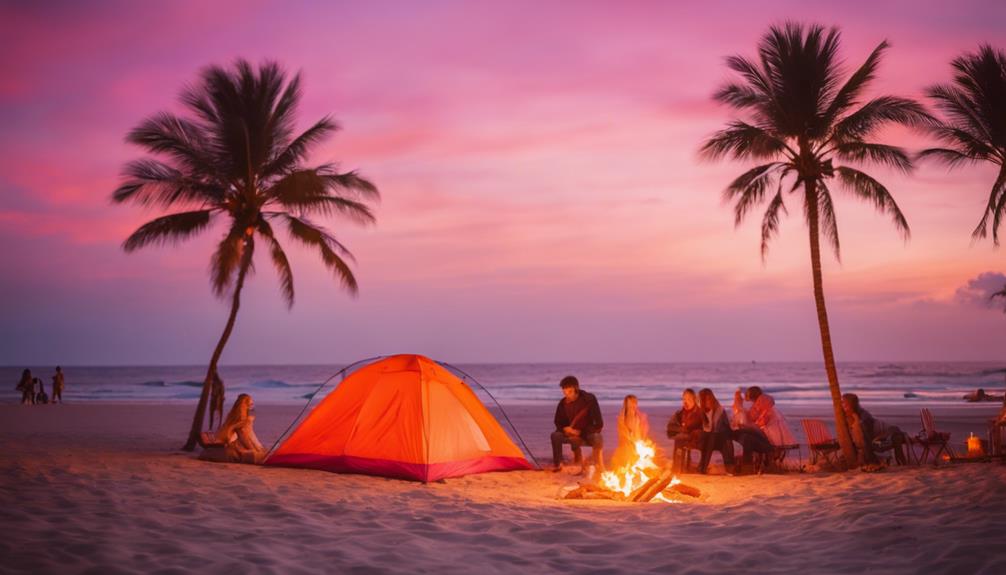To master camp cooking, choose between open fires and portable stoves based on safety, convenience, and your setting. Use lightweight, durable gear suited for your meal plans, focusing on simple, nutritious recipes that match your equipment. Plan ahead, organize ingredients efficiently, and practice proper fire safety. Stay flexible with backup options like dehydrated meals or energy bars for unexpected needs. Exploring these techniques further can help you cook confidently in any outdoor environment.
Key Takeaways
- Open fires allow for traditional cooking methods like grilling and roasting but require safety precautions and fire permits.
- Portable stoves offer cleaner, more controlled cooking with less fire risk and are suitable for various meal preparations.
- Choosing between open fire and stove depends on trip environment, safety, and meal complexity.
- Proper techniques include managing fire intensity, using appropriate cookware, and practicing fire safety standards.
- Combining both methods can maximize flexibility for diverse camp meals and safety considerations.

Are you ready to master camp cooking? Success begins with understanding how to leverage your portable gear and meal planning to make outdoor meals both efficient and enjoyable. When you’re out in the wilderness, your choice of portable gear directly impacts your ability to prepare fresh, satisfying food. Compact stoves, lightweight cookware, and versatile utensils are essential. Invest in quality portable gear that’s easy to pack and durable enough to withstand outdoor conditions. This gear allows you to cook a variety of meals without bulky equipment, saving space and reducing weight in your pack. Effective meal planning is equally critical—know what you’ll prepare each day before you leave home. This strategy minimizes the number of ingredients you carry and ensures you have everything needed, avoiding last-minute grocery runs or improvisation that can lead to subpar meals.
Start by selecting simple, nutritious recipes that require minimal prep and cooking time. Think one-pot dishes, dehydrated ingredients, or pre-cooked staples that only need reheating. When planning, consider how your portable gear functions—whether you’re using a backpacking stove, a propane setup, or an open fire. Match your meal choices to your gear’s capabilities, focusing on dishes that align with what your equipment can handle efficiently. For example, a compact backpacking stove is perfect for boiling water and cooking instant pasta or rice, while a larger, more stable camp stove can handle frying or simmering stews.
Choose recipes suited to your gear—simple, one-pot, dehydrated, or pre-cooked meals for efficient camp cooking.
Additionally, practicing safe fire and stove usage is crucial for both efficiency and safety in outdoor cooking. Also, organize your meals around ease of preparation. Pre-measure spices and ingredients at home and pack them in small, labeled containers. This saves time and keeps your gear organized. Use lightweight, durable containers to store ingredients, making it simple to access what you need without rummaging through your pack. When planning meals, think about energy requirements and balance—include high-protein options and fresh produce when possible, but always prioritize simplicity and convenience. Remember, your goal is to enjoy nourishing meals without fuss, so streamline your process wherever possible.
Finally, adapt your meal plans based on your specific trip duration and the availability of fuel or firewood. Flexibility is key; having backup options like dehydrated meals or energy bars ensures you won’t go hungry if your primary plan hits a snag. By combining thoughtful meal planning with the right portable gear, you’ll streamline your camp cooking process, making it easier to stay well-fed and focused on enjoying your outdoor adventure.
Frequently Asked Questions
What Are Eco-Friendly Camp Cooking Practices?
You can practice eco-friendly camp cooking by using sustainable ingredients to reduce environmental impact. Opt for biodegradable utensils and compostable dishware to minimize waste. Choose energy-efficient methods like portable stoves over open fires when possible, and always clean up thoroughly, leaving no trace. Avoid single-use plastics and support local suppliers for fresh, eco-conscious food options. These practices help preserve nature while enjoying your outdoor meals responsibly.
How Do I Prevent Wildlife From Accessing My Food?
To prevent wildlife from accessing your food, use effective wildlife deterrents like bear-proof containers or hanging food high in trees away from your campsite. Always store food securely, ideally in designated food storage lockers or bear canisters, and never leave it out overnight. Keep your cooking area clean, wipe down surfaces, and dispose of trash properly. These practices reduce scent trails, making your campsite less attractive to curious animals.
What Safety Tips Are Essential When Using Open Flames?
You should always keep fire safety top of mind when using open flames. Manage the flame carefully, never leave it unattended, and keep a bucket of water or a fire extinguisher nearby in case of emergencies. Confirm your cooking area is clear of flammable materials and set up your fire on a stable, non-flammable surface. Proper flame management and vigilant fire safety prevent accidents and protect both you and the environment.
How Can I Cook Gourmet Meals Outdoors?
Sure, you can cook gourmet meals outdoors—just embrace the challenge. Use outdoor flavor techniques like smoking and grilling to enhance taste, and focus on gourmet presentation to impress. Keep ingredients simple but fresh, and master precise timing. Pack quality tools, like portable stoves and sharp knives, to guarantee professional results. With patience and skill, you’ll enjoy restaurant-worthy dishes amid nature’s beauty.
What Are the Best Storage Methods for Perishable Ingredients?
You should prioritize refrigeration techniques like coolers with ice packs to keep perishable ingredients fresh, especially for longer trips. For shorter stays, use dry storage methods such as airtight containers in a shaded, cool spot to prevent spoilage. Always keep perishable items away from direct sunlight and heat, and pack only what you’ll use soon. Proper storage guarantees your ingredients stay safe and fresh, making your outdoor cooking both practical and enjoyable.
Conclusion
Mastering camp cooking techniques is like tending a wildfire—your skills grow stronger with practice and patience. Whether you’re grilling over an open fire or using a portable stove, each method adds a new brushstroke to your outdoor culinary canvas. Keep experimenting, adapt to your surroundings, and enjoy the journey. With these techniques, you’ll turn simple ingredients into memorable meals, fueling your adventure and igniting your passion for outdoor cooking.









